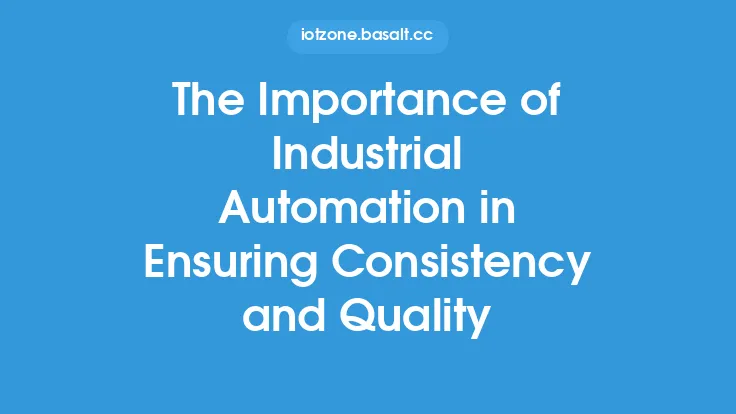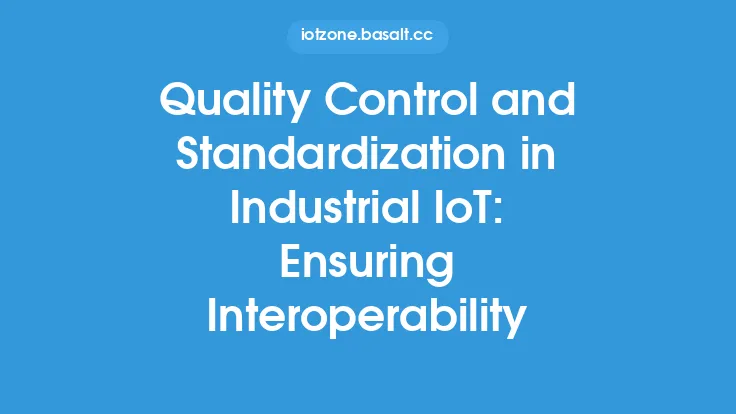The Industrial Internet of Things (IIoT) has revolutionized the way industries operate, making them more efficient, productive, and connected. However, with the increasing complexity and interconnectedness of IIoT systems, ensuring the quality of products and processes has become a critical concern. Quality control is essential in IIoT to guarantee that products meet the required standards, are reliable, and perform as expected. In this article, we will delve into the importance of quality control in IIoT, its benefits, and the challenges associated with implementing effective quality control measures.
Introduction to Quality Control in IIoT
Quality control in IIoT involves monitoring and controlling the quality of products and processes in real-time, using data analytics, machine learning, and other advanced technologies. The goal of quality control is to detect defects, anomalies, or deviations from the expected standards and take corrective actions to prevent or minimize their impact. In IIoT, quality control is not limited to the production process but also extends to the entire product lifecycle, including design, testing, and maintenance. Effective quality control in IIoT requires a deep understanding of the complex interactions between devices, systems, and processes, as well as the ability to analyze vast amounts of data generated by these systems.
Benefits of Quality Control in IIoT
The benefits of quality control in IIoT are numerous and significant. Some of the most important advantages include:
- Improved product quality: Quality control ensures that products meet the required standards, are reliable, and perform as expected, resulting in increased customer satisfaction and loyalty.
- Reduced waste and scrap: By detecting defects and anomalies in real-time, quality control can help reduce waste and scrap, resulting in cost savings and improved efficiency.
- Increased productivity: Quality control can help identify bottlenecks and inefficiencies in the production process, allowing for targeted improvements and increased productivity.
- Enhanced safety: Quality control can help detect potential safety hazards, such as equipment malfunctions or operator errors, and take corrective actions to prevent accidents.
- Regulatory compliance: Quality control can help ensure compliance with regulatory requirements and industry standards, reducing the risk of non-compliance and associated penalties.
Challenges of Implementing Quality Control in IIoT
Despite the benefits of quality control in IIoT, implementing effective quality control measures can be challenging. Some of the most significant challenges include:
- Complexity of IIoT systems: IIoT systems are often complex and interconnected, making it difficult to identify and isolate quality control issues.
- Data overload: IIoT systems generate vast amounts of data, making it challenging to analyze and interpret the data in real-time.
- Lack of standardization: IIoT systems often lack standardization, making it difficult to integrate quality control measures across different devices and systems.
- Cybersecurity risks: IIoT systems are vulnerable to cybersecurity risks, which can compromise quality control measures and put the entire system at risk.
- Skills and training: Implementing effective quality control measures in IIoT requires specialized skills and training, which can be a challenge for many organizations.
Technical Requirements for Quality Control in IIoT
To implement effective quality control measures in IIoT, several technical requirements must be met. These include:
- Advanced data analytics: Quality control in IIoT requires advanced data analytics capabilities, including machine learning, predictive analytics, and real-time data processing.
- IoT device management: Quality control requires effective management of IoT devices, including device monitoring, configuration, and maintenance.
- Network infrastructure: Quality control requires a robust and reliable network infrastructure, including wireless and wired connectivity, to support real-time data transmission and analysis.
- Cybersecurity: Quality control requires robust cybersecurity measures to protect against cyber threats and ensure the integrity of the system.
- Standardization: Quality control requires standardization of devices, systems, and processes to ensure interoperability and seamless integration.
Best Practices for Quality Control in IIoT
To overcome the challenges associated with implementing quality control in IIoT, several best practices can be followed. These include:
- Develop a quality control strategy: Develop a comprehensive quality control strategy that aligns with the organization's goals and objectives.
- Implement advanced data analytics: Implement advanced data analytics capabilities, including machine learning and predictive analytics, to analyze data in real-time.
- Use IoT device management: Use IoT device management tools to monitor, configure, and maintain IoT devices.
- Ensure cybersecurity: Ensure robust cybersecurity measures are in place to protect against cyber threats and ensure the integrity of the system.
- Collaborate with stakeholders: Collaborate with stakeholders, including suppliers, customers, and regulatory bodies, to ensure compliance with regulatory requirements and industry standards.
Conclusion
Quality control is essential in IIoT to ensure that products meet the required standards, are reliable, and perform as expected. The benefits of quality control in IIoT are numerous and significant, including improved product quality, reduced waste and scrap, increased productivity, enhanced safety, and regulatory compliance. However, implementing effective quality control measures in IIoT can be challenging due to the complexity of IIoT systems, data overload, lack of standardization, cybersecurity risks, and skills and training requirements. By following best practices, including developing a quality control strategy, implementing advanced data analytics, using IoT device management, ensuring cybersecurity, and collaborating with stakeholders, organizations can overcome these challenges and ensure effective quality control in IIoT.





